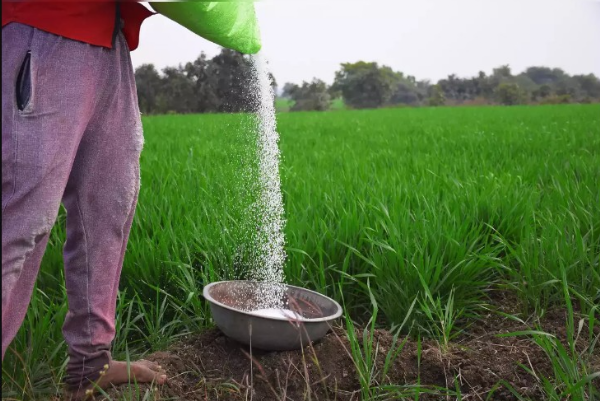India to stop importing urea by 2025. But how?
Total Views |
In a significant milestone, urea imports in the country witnessed a 21% decline in 2023, falling to 7.41 million metric tonnes (mt), according to the latest data available on the Department of Fertilizer’s website. Chemicals and Fertilisers Minister Mansukh Mandaviya has also assured that India will witness zero imports of urea by 2025. This development has taken place due to higher domestic production which helped to bridge the gap between supply and demand.

India requires 360 lakh metric tonnes of urea to meet domestic demand and in 2014 India was producing just 225 lakh metric tonnes of urea. The massive gap necessitated huge imports. However, now the installed domestic production capacities have been increased to around 310 lakh tonne. But how?
According to the government data, imports of urea fell to 75.8 lakh tonne in 2022-23 from 91.36 lakh tonne in the previous year. Urea imports stood at 98.28 lakh tonne in 2020-21, 91.23 lakh tonne in 2019-20 and 74.81 lakh tonne in 2018-19.
The government has rigorously worked to achieve self-sufficiency in urea production. It has adopted a two-pronged strategy to end dependency on urea imports
1. Domestic Production
2. Alternate fertilisers
The government introduced the New Urea Policy in 2015 to boost indigenous urea production. Therefore, it revived four closed urea plants - Gorakhpur in Uttar Pradesh, Ramagundam in Telangana, Barauni in Bihar, and Sindri in Jharkhand and is reviving one another factory - Talcher in Odisha - next year. With this, there was a substantial increase in domestic production, which saw a 13.4% rise last year, reaching 31.11 million mt, up from 27.43 million mt in 2022.
Apart from this, the new plant is projected to add 3.85 million mt per year of urea to domestic production, further strengthening the country's position in the fertilizer sector.
Aiming to promote, the government is taking steps to popularise the use of alternate fertilizers like nano liquid urea and nano liquid di-ammonium phosphate (DAP). These fertilizers are considered good for crops and soil health.
To make this happen, Indian Farmers Fertiliser Cooperative Limited (IFFCO) has operationalised three Nano Urea plants at Kalol (Gujrat), Phulpur, and Aonla in Uttar Pradesh, with a capacity of 17 crore bottles. One 500-ml bottle of Nano Urea is equivalent to one bag (45 kg) of conventional urea. IFFCO has started producing Diammonium Phosphate (DAP) at its Kalol plant and plans to commission two more plants at Kandla and Paradeep. Coromandel International Limited (CIL) has also set up a Nano DAP production facility in Andhra Pradesh, which has a manufacturing capacity of 4 crore bottles (1 litre each) per year.
It has also launched 'PM Programme for Restoration, Awareness, Nourishment and Amelioration of Mother Earth' (PM-PRANAM) scheme to incentivise states and Union Territories (UTs) to promote the usage of alternative fertilisers and balanced use of chemical fertilisers.
Expanding domestic fertilizer production capacity is part of India's broader strategy to reduce dependency on imports and ensure a stable supply of urea for its agricultural sector, thereby supporting the nation's food security and agricultural productivity.

Urea Imports by India
India requires 360 lakh metric tonnes of urea to meet domestic demand and in 2014 India was producing just 225 lakh metric tonnes of urea. The massive gap necessitated huge imports. However, now the installed domestic production capacities have been increased to around 310 lakh tonne. But how?
According to the government data, imports of urea fell to 75.8 lakh tonne in 2022-23 from 91.36 lakh tonne in the previous year. Urea imports stood at 98.28 lakh tonne in 2020-21, 91.23 lakh tonne in 2019-20 and 74.81 lakh tonne in 2018-19.
The government has rigorously worked to achieve self-sufficiency in urea production. It has adopted a two-pronged strategy to end dependency on urea imports
1. Domestic Production
2. Alternate fertilisers
1. Reviving Domestic Production
The government introduced the New Urea Policy in 2015 to boost indigenous urea production. Therefore, it revived four closed urea plants - Gorakhpur in Uttar Pradesh, Ramagundam in Telangana, Barauni in Bihar, and Sindri in Jharkhand and is reviving one another factory - Talcher in Odisha - next year. With this, there was a substantial increase in domestic production, which saw a 13.4% rise last year, reaching 31.11 million mt, up from 27.43 million mt in 2022.
Apart from this, the new plant is projected to add 3.85 million mt per year of urea to domestic production, further strengthening the country's position in the fertilizer sector.
2. Alternative fertilisers
Aiming to promote, the government is taking steps to popularise the use of alternate fertilizers like nano liquid urea and nano liquid di-ammonium phosphate (DAP). These fertilizers are considered good for crops and soil health.
To make this happen, Indian Farmers Fertiliser Cooperative Limited (IFFCO) has operationalised three Nano Urea plants at Kalol (Gujrat), Phulpur, and Aonla in Uttar Pradesh, with a capacity of 17 crore bottles. One 500-ml bottle of Nano Urea is equivalent to one bag (45 kg) of conventional urea. IFFCO has started producing Diammonium Phosphate (DAP) at its Kalol plant and plans to commission two more plants at Kandla and Paradeep. Coromandel International Limited (CIL) has also set up a Nano DAP production facility in Andhra Pradesh, which has a manufacturing capacity of 4 crore bottles (1 litre each) per year.
It has also launched 'PM Programme for Restoration, Awareness, Nourishment and Amelioration of Mother Earth' (PM-PRANAM) scheme to incentivise states and Union Territories (UTs) to promote the usage of alternative fertilisers and balanced use of chemical fertilisers.
Expanding domestic fertilizer production capacity is part of India's broader strategy to reduce dependency on imports and ensure a stable supply of urea for its agricultural sector, thereby supporting the nation's food security and agricultural productivity.

